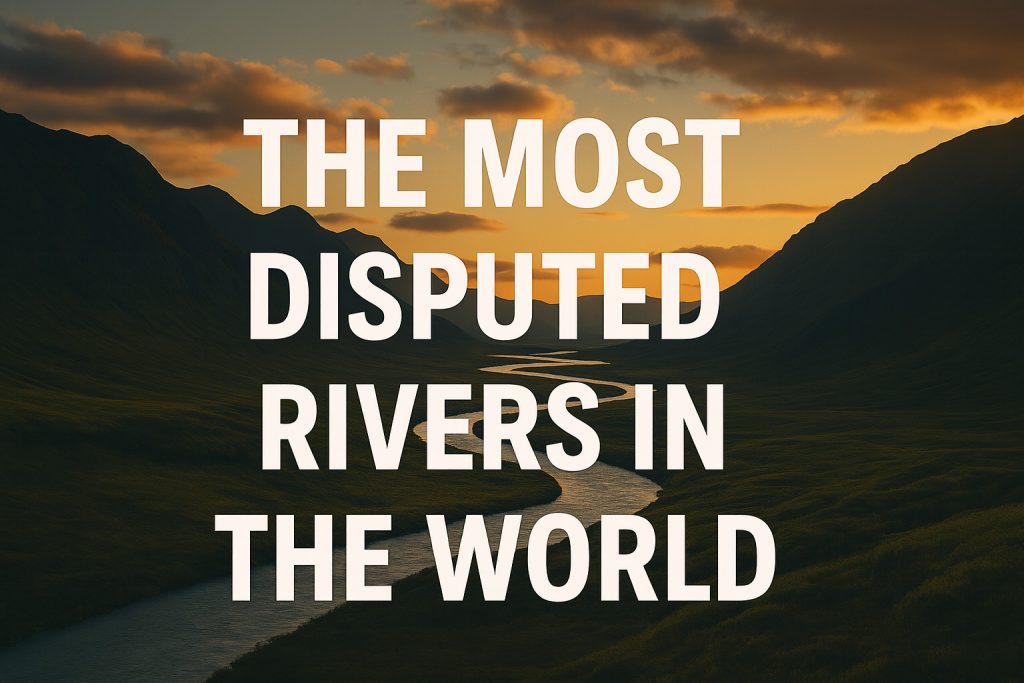Explore the world’s most disputed rivers—where borders, dams, and water rights spark tensions from the Nile to the Brahmaputra and beyond.
Rivers have always been lifelines since ancient civilizations—sources of food, transport, and energy. But when they flow across political borders or through regions with scarce water, they can become flashpoints for conflict. From grand hydropower dams to contested headwaters, the world’s most disputed rivers are as much about politics as they are about geography.
1. Nile River — Ethiopia vs. Egypt (and Sudan)
The Nile is the world’s longest river, but its waters are far from peacefully shared. At the heart of the dispute lies the Grand Ethiopian Renaissance Dam (GERD), a massive hydropower project built upstream on the Blue Nile in Ethiopia. For over a decade, this single dam has reshaped the geopolitics of northeast Africa.
- Egypt’s concern: More than 90% of Egypt’s freshwater comes from the Nile, and any significant reduction in flow could devastate its agriculture, industry, and drinking water supply. Egyptian leaders warn that the GERD could threaten national survival if not managed cooperatively.
- Ethiopia’s argument: With millions still lacking electricity, Ethiopia sees the GERD as a symbol of progress and sovereignty. The dam promises to be Africa’s largest hydropower facility, capable of transforming the country’s economy.
- Current status: Years of African Union–brokered talks, U.S. involvement, and other international mediation efforts have so far failed to produce a binding agreement on dam filling and operation. Meanwhile, Ethiopia continues to fill its reservoir in stages, heightening tensions downstream.
2. Brahmaputra / Yarlung Tsangpo — China vs. India (and Bangladesh)
High in Tibet, the Yarlung Tsangpo carves a dramatic gorge before crossing into India’s Arunachal Pradesh as the Brahmaputra and finally fanning into the fertile plains of Bangladesh. Its journey spans fragile ecosystems and sensitive political borders.
- India and Bangladesh’s concern: China’s upstream dam-building plans—particularly in the Great Bend region—could alter seasonal flows, reduce sediment delivery, and affect agriculture and fisheries downstream.
- China’s argument: Projects are presented as “run-of-the-river” hydropower with minimal water diversion, aimed at generating clean energy for its western provinces.
- Current status: No formal water-sharing treaty exists between China and India. Data-sharing agreements are limited, and mutual suspicion persists, especially given the broader border disputes between the two countries.
3. Mekong River — China vs. Southeast Asia
Rising on the Tibetan Plateau, the Mekong sustains over 60 million people across six nations. China, controlling the river’s upper course, has built a cascade of mega-dams, while Laos has embraced its own hydropower boom.
- Downstream nations’ concern: Altered flow regimes, reduced fish stocks, and declining fertility in the Mekong Delta, which is vital for Vietnam’s rice production.
- China and Laos’ argument: Hydropower provides energy security, revenue, and infrastructure growth.
- Current status: The Mekong River Commission includes most lower-basin countries but not China, limiting its power to regulate upstream decisions. Prolonged droughts in recent years have intensified calls for more transparent water management.
4. Indus River — India vs. Pakistan
Fed by Himalayan glaciers and snowmelt, the Indus is Pakistan’s agricultural lifeline. Most of its tributaries, however, flow through Indian-administered territory before crossing the border.
- Pakistan’s concern: Indian hydropower projects in Kashmir could store or divert water, especially during politically tense periods.
- India’s argument: All projects comply with the 1960 Indus Waters Treaty, which gives each country control over specific tributaries.
- Current status: The treaty has survived wars and diplomatic breakdowns, but climate change, glacial retreat, and growing demand are testing its resilience.
5. Jordan River — Israel, Jordan, and Palestine
Once a wide and fast-flowing river, the Jordan has been reduced to a trickle in many stretches due to decades of diversion.
- Palestinian and Jordanian concern: Unequal water access and declining water quality, compounded by population growth and drought.
- Israeli argument: Diversions and usage are necessary for national water security, though Israel has also developed desalination to ease pressure on the river.
- Current status: Small-scale cooperative projects exist, including efforts to restore flows to the lower Jordan, but political instability frequently stalls progress.
6. Amu Darya & Syr Darya — Central Asian Water Wars
Once feeding the Aral Sea, these two rivers flow through five Central Asian states, each with different water needs.
- Downstream states’ concern (Uzbekistan, Turkmenistan, Kazakhstan): Upstream dams in Kyrgyzstan and Tajikistan reduce water availability for irrigation-heavy economies, particularly for cotton.
- Upstream argument: Hydropower is essential for winter electricity production, and water release schedules are dictated by energy needs, not downstream farming cycles.
- Current status: Regional agreements exist but are loosely enforced, leading to annual disputes, especially in drought years.
7. Colorado River — U.S. vs. Mexico (and U.S. States)
Once wild and untamed, the Colorado now fails to reach the sea most years. Its flow is divided between seven U.S. states and Mexico under a century-old compact.
- Mexico’s concern: Reduced flows harm agriculture in the Mexicali Valley and damage the once-vibrant Colorado River Delta.
- U.S. argument: Water allocations are legally binding but must be adjusted to reflect reduced river volume due to climate change.
- Current status: Emergency shortage declarations have led to negotiated cuts, but demand still exceeds supply, raising fears of a deeper water crisis.
8. Danube River — Hydropower and Ecology in Europe
Europe’s second-longest river flows through 10 countries, making it a model of both cooperation and conflict.
- Environmentalists’ concern: Large hydropower and navigation projects, such as the controversial Gabčíkovo–Nagymaros Dam, disrupt fish migration, alter floodplains, and threaten biodiversity.
- Pro-development argument: Hydropower and improved navigation are essential for economic growth and regional trade.
- Current status: The International Commission for the Protection of the Danube River mediates between countries, balancing energy needs with conservation, but disagreements over specific projects remain unresolved.
Why Rivers Become Disputed
Water is rarely just water—it’s life, livelihood, and sometimes a matter of national survival. When rivers cross political boundaries, their control becomes a complex mix of geography, economics, and identity. Several recurring factors fuel disputes:
1. Shared Borders
Many rivers serve as natural borders between countries or regions. Control over these boundary waters is not just about resource use—it’s about sovereignty. A shift in the river’s course due to flooding or erosion can alter the exact border, creating fertile ground for disputes. Examples include the shifting channels of the Mekong and the constantly changing Amu Darya in Central Asia.
2. Hydropower Projects
Upstream dam construction can radically alter a river’s flow, sediment load, and seasonal rhythm. Downstream countries fear that their agriculture, fisheries, and drinking water supply could be compromised. Projects like Ethiopia’s GERD on the Nile or China’s dam cascade on the Mekong have shown how infrastructure built for national energy goals can be seen as a threat by neighbors.
3. Climate Change
Melting glaciers, shifting rainfall patterns, and prolonged droughts are changing river flows worldwide. In many basins, declining water levels turn once-manageable differences into urgent disputes. The Colorado River, for instance, has seen decades of reduced snowpack in the Rockies, intensifying conflicts between U.S. states and Mexico.
4. National Pride and Symbolism
Rivers are deeply woven into national myths, histories, and identities. Control over a famous waterway can be seen as a symbol of independence, resilience, or even divine right. This makes compromise difficult—leaders may resist concessions not because they lack water, but because the river is tied to their nation’s image.
The Future of River Diplomacy
As populations grow and climate change disrupts water cycles, the pressure on shared rivers will only intensify. The question is not whether disputes will arise, but whether nations can manage them without conflict. The future of river diplomacy will depend on several key shifts:
1. Adaptive Treaties
Many existing water-sharing agreements were signed decades ago, under climatic and demographic conditions that no longer exist. Successful diplomacy will require treaties that can evolve—allowing flexible allocations, drought provisions, and emergency clauses that respond to changing realities.
2. Data Transparency
Trust begins with knowledge. Disputes often flare because downstream countries suspect upstream neighbors of withholding information on dam releases, rainfall, or planned projects. Basin-wide data-sharing systems, often supported by satellite monitoring, can build trust and prevent misunderstandings.
3. Integrating Energy, Food, and Water Planning
Rivers aren’t just water sources—they power turbines, irrigate crops, and sustain fisheries. Future agreements must take a nexus approach, addressing hydropower, agriculture, and ecosystem health together rather than in isolation.
4. Regional Institutions and Mediation
River basin commissions like the International Commission for the Protection of the Danube River show that multi-country dialogue can work. Similar bodies in Africa, Asia, and the Americas could provide neutral platforms for negotiation, backed by scientific expertise rather than political posturing.
5. Public Awareness and Pressure
Citizen movements, from local fishermen to global climate activists, increasingly influence river management decisions. Public pressure can push governments toward cooperation rather than confrontation—especially when environmental and economic stakes are widely understood.
In short: The rivers of the future will test diplomacy as much as engineering. Those that flow in peace will do so because nations chose dialogue over dominance, and long-term resilience over short-term gain.


